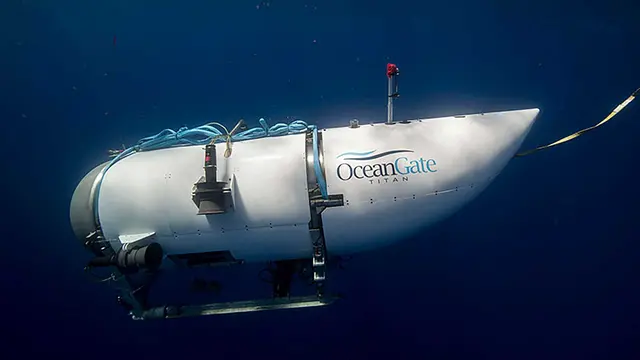The clock is ticking on rescue efforts to find five people in a missing submersible in the North Atlantic Ocean.
The commercial vessel Titan by the company OceanGate lost contact with its research ship at 5:45 a.m. eastern on Sunday, June 18.
At the time, it was at about 3,500 meters (2.2 miles) below sea level, experts believe, and nearing it's destination of the wreck of the Titanic, which is located 3,800 meters (2.3 miles) below sea level.
The submersible has an estimated a maximum emergency oxygen capacity of 96 hours, or about four days.
Oceanographer Simon Boxall told the UK PA Media that he had "second-hand knowledge" that the Titan sent an emergency distress signal, but he did not know when.
The distress signal would have been in the form of a "ping", a limited form of sound communication.
The Titan also pings its research ship every 15 minutes to share it's location. The last such ping was at 10 a.m. on Sunday, the Times of London reports.
The U.S. Coast Guard and Canadian aircraft have been searching the area since Sunday and have so far covered 10,000 square miles of ocean surface with no result.
If the submersible is still underwater, few vessels on earth are capable of going to such depths as the Titanic, and they can take weeks to prepare for such a task.
OceanGate's Titanic expedition has been carried out successfully at least 25 times over the last three years.
The Titan vessel normally takes about two hours to travel to the Titanic where researchers and tourists view the wreck for a few hours.
When the sub is ready to return to the surface, it releases its weight and rises to the surface, which takes about two hours.
There are seven different ways for the submersible to return to the surface, a few even if it has no electricity, said CBS reporter David Pogue who traveled on the Titan in 2022.
"One even works if everyone is passed out," Pogue said in a CBS interview. "It's a time released sandbag that after 14 hours drops off by itself. So this thing should be bobbing on the surface."
EXPERIMENTAL VESSEL
The Titan submersible is 22 feet long - about the length of two basketball hoops, 9 feet wide, and 8 feet high. The body is made up of five-inch-think carbon fiber and two titanium end caps on either side.
OceanGate worked with NASA, Boeing and the University of Washington to develop it's experimental carbon fiber hull. Conventional submersibles are made entirely of steel, aluminum or titanium.
The New Republic has also reported that former OceanGate employee David Lochridge had complained that the Titan was not capable of traveling to such depths. Lochridge was later fired and the company sued him for disclosing confidential information about the vessel. He also countersued the company for wrongful termination.
Tourists pay $250,000 each to travel on the Titan to the Titanic and must sign a statement that reads that they are aware the Titan is an "experimental submersible vessel that has not been approved or certified by any regulatory body and could result in physical injury, disability, emotional trauma, or death."
Submersibles differ from submarines because they are not autonomously navigable. The Titan relies on it's research ship to send text messages telling them where to go.
Once directions from the ship are given, the vessel itself has four electric thrusters operated by a off-the-shelf video game controller.
While this may seem surprising, it's increasingly common for the military to operate tanks and submarines using game controllers, VICE reports. For example, the U.S. Navy uses Xbox controllers on its submarines.
WHAT COULD HAVE HAPPENED?
Some experts have speculated that the submersible got caught on something in the deep sea or even on part of the Titanic's wreckage. This would explain why it hasn't risen to the surface.
It's also possible there was a hull breach and the vessel imploded.
If an implosion took place, military hydrophones in the ocean would likely have picked it up. In 2017, when an Argentine submarine was lost, hydrophones detected sounds consistent with catastrophic failure of the submarine, the Guardian reports.
If the submersible made it to the surface of the water and still cannot contact its research ship, the vessel can only be unbolted from the outside, so available oxygen would still be critical to survival.
(CGTN)
 简体中文
简体中文

